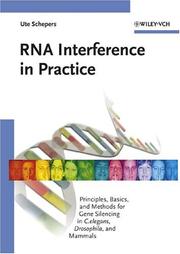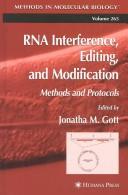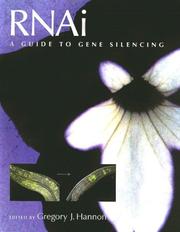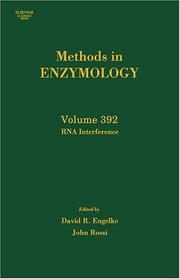| Listing 1 - 10 of 36 | << page >> |
Sort by
|
Book
Year: 2014 Publisher: Bruxelles: UCL,
Abstract | Keywords | Export | Availability | Bookmark
 Loading...
Loading...Choose an application
- Reference Manager
- EndNote
- RefWorks (Direct export to RefWorks)
Since the discovery regarding interference phenomenon, 20 years ago, RNA interference became standard method to suppress a gene expression into in vitro tests. Nowadays, the point of interest lies in vivo studies. The RNAi could be used as strong tool in specific therapy going from viral infection to cancer, if only the RNAi would have a proper structure. The main obstacle to RNAi potential therapeutic action is due to a difficulty small interfering RNA (siRNA) at the level of its action in vivo. An effective delivery strategy of siRNA must consider some limitations: (i) poor stability, (ii) undesirable non-specific immune response, (iii) a distribution in non-targeted tissues. The development of such a strategy requires a careful understanding of all the mechanisms of action of RNAi, engineering developed to overcome barriers to the delivery of siRNA, the site of action, and finally a clinical trial. This analysis allows us to offer a perspective on the therapeutic use of siRNA in human.
Book
ISBN: 9781578087167 Year: 2011 Publisher: Enfield (N.H.) : CRC Press,
Abstract | Keywords | Export | Availability | Bookmark
 Loading...
Loading...Choose an application
- Reference Manager
- EndNote
- RefWorks (Direct export to RefWorks)
Biomedical technology. --- Gene silencing. --- Rna interference. --- Small interfering rna.

ISBN: 3527310207 9783527310203 Year: 2005 Publisher: Weinheim : Wiley-VCH,
Abstract | Keywords | Export | Availability | Bookmark
 Loading...
Loading...Choose an application
- Reference Manager
- EndNote
- RefWorks (Direct export to RefWorks)
Gene targeting --- RNA --- Gènes --- ARN --- Ciblage --- RNA editing. --- RNA Interference. --- Gènes
Book
Abstract | Keywords | Export | Availability | Bookmark
 Loading...
Loading...Choose an application
- Reference Manager
- EndNote
- RefWorks (Direct export to RefWorks)
Neurodegenerative diseases (NDs) are a heterogeneous group of disorders affecting the central nervous system. Despite significant differences in their causes, neuropathological abnormalities, and clinical outcomes, some similarities can be found among them, as for example: 1) frequent aggregation and deposition of misfolded proteins, 2) common molecular mechanisms leading to neurodegeneration, and 3) certain overlap in symptoms and clinical features. To date, there is no cure that could stop or delay the progression of these diseases. The advent of advanced gene therapy techniques such as gene silencing and gene editing opened a new avenue for the development of therapeutic strategies for NDs. The discovery of the RNA interference (RNAi) mechanism, in 1998, by Andrew Fire and Craig Mello allowed an important boost to the gene therapy field, providing a potential therapeutic strategy to treat inherited dominant genetic disorders. The use of small RNA sequences to control the expression of disease-causing genes rapidly implemented in the preclinical studies for different diseases. In the field of NDs, several successful studies using this technology proved its potential as a therapeutic option. However, issues like the type of delivery system (non-viral versus viral) or the potential toxicity of the small RNA molecules, made the translation of gene silencing therapeutics to human application very slow and difficult. Recently, a new hope in the gene therapy field emerged with the development of gene editing techniques like TALENs or CRISPR/Cas9 systems. The opportunity of editing or deleting gene sequences drove the scientific community euphoric, with an enormous increase in the number of published studies using this type of techniques. Recently, the first clinical trial using one of these systems was approved in China. For NDs, gene-editing technology also represents an important therapeutic option, and the first preclinical studies are now being published, showing the potential accomplishment for this technology.
Gene silencing --- Long non-coding RNAs --- RNA interference --- Neurodegenerative diseases --- CRISPR/Cas9 --- Neurodegeneration --- Gene editing --- Antisense oligonucleotides --- Neuroinflammation --- iPS cells --- Gene silencing --- Long non-coding RNAs --- RNA interference --- Neurodegenerative diseases --- CRISPR/Cas9 --- Neurodegeneration --- Gene editing --- Antisense oligonucleotides --- Neuroinflammation --- iPS cells
Book
Abstract | Keywords | Export | Availability | Bookmark
 Loading...
Loading...Choose an application
- Reference Manager
- EndNote
- RefWorks (Direct export to RefWorks)
Neurodegenerative diseases (NDs) are a heterogeneous group of disorders affecting the central nervous system. Despite significant differences in their causes, neuropathological abnormalities, and clinical outcomes, some similarities can be found among them, as for example: 1) frequent aggregation and deposition of misfolded proteins, 2) common molecular mechanisms leading to neurodegeneration, and 3) certain overlap in symptoms and clinical features. To date, there is no cure that could stop or delay the progression of these diseases. The advent of advanced gene therapy techniques such as gene silencing and gene editing opened a new avenue for the development of therapeutic strategies for NDs. The discovery of the RNA interference (RNAi) mechanism, in 1998, by Andrew Fire and Craig Mello allowed an important boost to the gene therapy field, providing a potential therapeutic strategy to treat inherited dominant genetic disorders. The use of small RNA sequences to control the expression of disease-causing genes rapidly implemented in the preclinical studies for different diseases. In the field of NDs, several successful studies using this technology proved its potential as a therapeutic option. However, issues like the type of delivery system (non-viral versus viral) or the potential toxicity of the small RNA molecules, made the translation of gene silencing therapeutics to human application very slow and difficult. Recently, a new hope in the gene therapy field emerged with the development of gene editing techniques like TALENs or CRISPR/Cas9 systems. The opportunity of editing or deleting gene sequences drove the scientific community euphoric, with an enormous increase in the number of published studies using this type of techniques. Recently, the first clinical trial using one of these systems was approved in China. For NDs, gene-editing technology also represents an important therapeutic option, and the first preclinical studies are now being published, showing the potential accomplishment for this technology.
Gene silencing --- Long non-coding RNAs --- RNA interference --- Neurodegenerative diseases --- CRISPR/Cas9 --- Neurodegeneration --- Gene editing --- Antisense oligonucleotides --- Neuroinflammation --- iPS cells
Book
Abstract | Keywords | Export | Availability | Bookmark
 Loading...
Loading...Choose an application
- Reference Manager
- EndNote
- RefWorks (Direct export to RefWorks)
Neurodegenerative diseases (NDs) are a heterogeneous group of disorders affecting the central nervous system. Despite significant differences in their causes, neuropathological abnormalities, and clinical outcomes, some similarities can be found among them, as for example: 1) frequent aggregation and deposition of misfolded proteins, 2) common molecular mechanisms leading to neurodegeneration, and 3) certain overlap in symptoms and clinical features. To date, there is no cure that could stop or delay the progression of these diseases. The advent of advanced gene therapy techniques such as gene silencing and gene editing opened a new avenue for the development of therapeutic strategies for NDs. The discovery of the RNA interference (RNAi) mechanism, in 1998, by Andrew Fire and Craig Mello allowed an important boost to the gene therapy field, providing a potential therapeutic strategy to treat inherited dominant genetic disorders. The use of small RNA sequences to control the expression of disease-causing genes rapidly implemented in the preclinical studies for different diseases. In the field of NDs, several successful studies using this technology proved its potential as a therapeutic option. However, issues like the type of delivery system (non-viral versus viral) or the potential toxicity of the small RNA molecules, made the translation of gene silencing therapeutics to human application very slow and difficult. Recently, a new hope in the gene therapy field emerged with the development of gene editing techniques like TALENs or CRISPR/Cas9 systems. The opportunity of editing or deleting gene sequences drove the scientific community euphoric, with an enormous increase in the number of published studies using this type of techniques. Recently, the first clinical trial using one of these systems was approved in China. For NDs, gene-editing technology also represents an important therapeutic option, and the first preclinical studies are now being published, showing the potential accomplishment for this technology.
Gene silencing --- Long non-coding RNAs --- RNA interference --- Neurodegenerative diseases --- CRISPR/Cas9 --- Neurodegeneration --- Gene editing --- Antisense oligonucleotides --- Neuroinflammation --- iPS cells
Book
ISBN: 3319251228 3319251244 Year: 2016 Publisher: Cham : Springer International Publishing : Imprint: Springer,
Abstract | Keywords | Export | Availability | Bookmark
 Loading...
Loading...Choose an application
- Reference Manager
- EndNote
- RefWorks (Direct export to RefWorks)
This book examines how post-transcriptional mechanisms control endocrine function. This includes newly identified regulatory mechanisms involved in hormone biosynthesis, control of hormone receptors and the outputs of hormone mediated signal transduction. Chapters address endocrine hormones including protein peptide/peptide, steroid, and non-steroidal hormones. The impacts of these mechanisms on disease and health are covered, providing a novel update to the scientific literature. Post-transcriptional regulatory mechanisms play an essential role in controlling dynamic gene expression. The outcome of this regulation includes control of the amount, timing, and location of protein expression. Regulation is mediated by cis-acting RNA sequences and structures and transacting RNA binding proteins and non-coding RNAs, including microRNAs. Recent advances in characterization of these regulatory factors have revealed enormous regulatory potential.
Physiology --- Human Anatomy & Physiology --- Health & Biological Sciences --- Endocrinology. --- RNA interference. --- Co-suppression (RNA interference) --- Interference, RNA --- Post-transcriptional gene silencing --- RNA silencing --- RNAi (RNA interference) --- Internal medicine --- Hormones --- Gene silencing --- Human physiology. --- Gene expression. --- Human Physiology. --- Gene Expression. --- Genes --- Genetic regulation --- Human biology --- Medical sciences --- Human body --- Expression --- Endocrinology .

ISBN: 1588292428 1592597750 1280360267 9786610360260 Year: 2004 Volume: 265 Publisher: Totowa, NJ : Humana Press : Imprint: Humana,
Abstract | Keywords | Export | Availability | Bookmark
 Loading...
Loading...Choose an application
- Reference Manager
- EndNote
- RefWorks (Direct export to RefWorks)
The study of RNA interference, editing, and modification has led to major shifts in our understanding of how genes are expressed and regulated. In RNA Interference, Editing, and Modification: Methods and Protocols, hands-on experimentalists describe in detail the protocols and assays they have developed to study these processes in most of the major biological systems in which they are known to occur-a wide range of organisms that includes worms, flies, trypanosomes, mammals, and plants. A historical overview of each subject is provided to put related chapters into a larger context. RNA interference (RNAi) has also emerged in recent years as an important and promising tool for gene discovery and reverse genetic engineering. Application of this cutting-edge technique is described for a range of experimental systems. Topics of interest include stable and transient RNA interference, RNA editing, gene silencing, bioinformatics, small noncoding RNAs, and RNomics. Special attention is given to methods for the identification and characterization of small RNAs, many of which are involved in RNA interference or modification. In addition, techniques used to study RNA editing mechanisms are elaborated for both systems that involve the conversion of one base to another and insertion-deletion editing. To promote the adaptation of their assays and approaches for use in other biological systems, the authors have included a range of methods representative of the major experimental systems in a given field. All protocols presented follow the successful Methods in Molecular Biology™ series format, each one offering step-by-step laboratory instructions, an introduction outlining the principle behind the technique, lists of equipment and reagents, and tips on troubleshooting and avoiding known pitfalls. State-of-the-art and highly practical, RNA Interference, Editing, and Modification: Methods and Protocols offers not only geneticists, molecular biologists, and bioinformaticists a comprehensive collection of readily reproducible techniques for the elucidation of gene function and the alteration of gene expression, but also describes how best they may be productively used to address outstanding mechanistic questions and adapted to novel biological systems.
RNA Editing --- RNA Interference --- RNA editing --- ARN --- Laboratory manuals. --- Edition --- Manuels de laboratoire --- RNA editing -- Laboratory manuals. --- Laboratory Manuals --- Publication Formats --- RNA Processing, Post-Transcriptional --- Gene Silencing --- Epigenesis, Genetic --- Biochemical Processes --- Publication Characteristics --- Metabolism --- Gene Expression Regulation --- Genetic Processes --- Chemical Processes --- Metabolic Phenomena --- Biochemical Phenomena --- Genetic Phenomena --- Chemical Phenomena --- Phenomena and Processes --- Genetics --- Biology - General --- Biochemistry --- Biology --- Chemistry --- Health & Biological Sciences --- Physical Sciences & Mathematics --- Editing, RNA --- Messenger RNA editing --- mRNA editing --- Genetic regulation --- Biochemistry. --- Biochemistry, general. --- Biological chemistry --- Chemical composition of organisms --- Organisms --- Physiological chemistry --- Medical sciences --- Composition --- Genetic regulation. --- Genetic Phenomena. --- Rna editing --- Rna interference

ISBN: 0879697040 0879696419 Year: 2003 Publisher: Cold Spring Harbor Cold Spring Harbor laboratory press
Abstract | Keywords | Export | Availability | Bookmark
 Loading...
Loading...Choose an application
- Reference Manager
- EndNote
- RefWorks (Direct export to RefWorks)
genetica --- moleculaire biologie --- Molecular biology --- RNA (ribonucleic acid) --- Gene silencing --- RNA --- Inactivation génétique --- ARN --- 577.213 --- Reproduction of inheritance information. Replication --- Gene silencing. --- RNA. --- 577.213 Reproduction of inheritance information. Replication --- Inactivation génétique --- Ribonucleic acid --- Ribose nucleic acid --- Nucleic acids --- Ribose --- Gene inactivation --- Inactivation, Gene --- Silencing, Gene --- Genetic regulation --- Genetic regulation. --- Genetic Phenomena. --- Genetic Phenomena --- Rna interference

ISSN: 00766879 ISBN: 0121827976 9786610633395 1280633395 0080455395 9780121827977 Year: 2005 Volume: 392 Publisher: Amsterdam Elsevier
Abstract | Keywords | Export | Availability | Bookmark
 Loading...
Loading...Choose an application
- Reference Manager
- EndNote
- RefWorks (Direct export to RefWorks)
The critically acclaimed laboratory standard, Methods in Enzymology, is one of the most highly respected publications in the field of biochemistry. Since 1955, each volume has been eagerly awaited, frequently consulted, and praised by researchers and reviewers alike. The series contains much material still relevant today - truly an essential publication for researchers in all fields of life sciences.RNA Interference will cover RNAi in non-vertebrates (plants, C. elegans, drosophila, and S. pombe), and Mammalian systems (human and non-human cells). This volume discusses e
RNA Interference. --- Small interfering RNA. --- RNA Interference --- RNA, Small Interfering --- Gene Silencing --- Epigenesis, Genetic --- RNA, Antisense --- RNA, Small Untranslated --- RNA --- Antisense Elements (Genetics) --- RNA, Untranslated --- Gene Expression Regulation --- Nucleic Acids, Nucleotides, and Nucleosides --- Genetic Processes --- Nucleic Acids --- Genetic Phenomena --- Chemicals and Drugs --- Phenomena and Processes --- RNA editing --- Gene silencing --- Small interfering RNA --- piRNA (Piwi-interacting RNA) --- Piwi-interacting RNA --- Piwi protein-interacting RNA --- rasiRNA (Repeat-associated small interfering RNA) --- Repeat-associated siRNA --- Repeat-associated small interfering RNA --- Scan RNA --- scnRNA (Small scan RNA) --- Short hairpin RNA --- Short interfering RNA --- shRNA (Short hairpin RNA) --- siRNA (Small interfering RNA) --- Small hairpin RNA --- Small scan RNA --- tasiRNA (Trans-acting small interfering RNA) --- Trans-acting siRNA --- Trans-acting small interfering RNA --- Gene inactivation --- Inactivation, Gene --- Silencing, Gene --- Editing, RNA --- Messenger RNA editing --- mRNA editing --- Ribonucleic acid --- Ribose nucleic acid --- Antisense RNA --- Genetic regulation --- Nucleic acids --- Ribose
| Listing 1 - 10 of 36 | << page >> |
Sort by
|

 Search
Search Feedback
Feedback About UniCat
About UniCat  Help
Help News
News